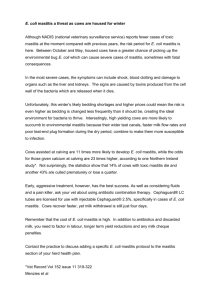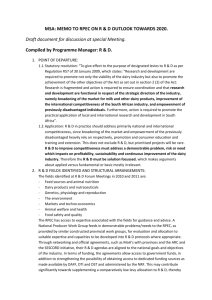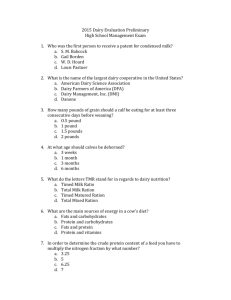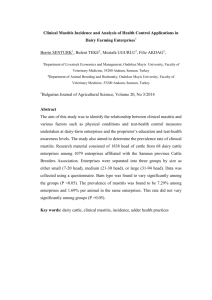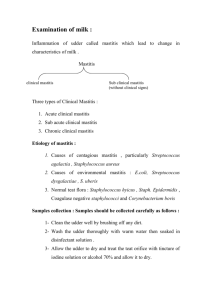On Farm Culturing for Better Milk Quality
advertisement
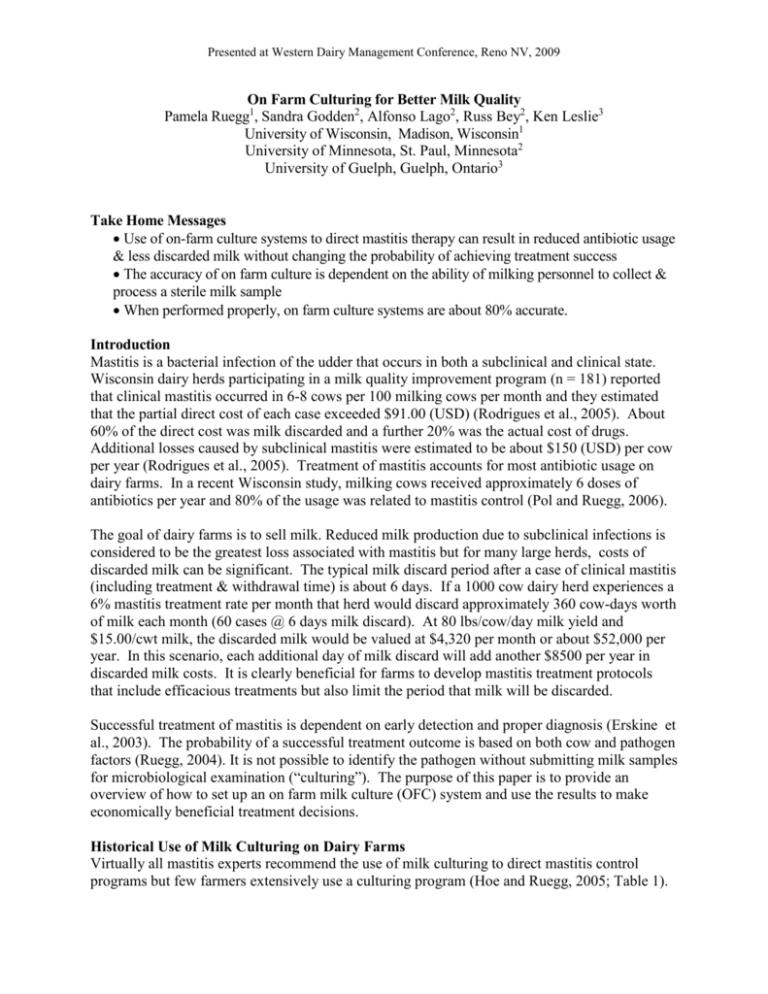
Presented at Western Dairy Management Conference, Reno NV, 2009 On Farm Culturing for Better Milk Quality Pamela Ruegg1, Sandra Godden2, Alfonso Lago2, Russ Bey2, Ken Leslie3 University of Wisconsin, Madison, Wisconsin1 University of Minnesota, St. Paul, Minnesota2 University of Guelph, Guelph, Ontario3 Take Home Messages Use of on-farm culture systems to direct mastitis therapy can result in reduced antibiotic usage & less discarded milk without changing the probability of achieving treatment success The accuracy of on farm culture is dependent on the ability of milking personnel to collect & process a sterile milk sample When performed properly, on farm culture systems are about 80% accurate. Introduction Mastitis is a bacterial infection of the udder that occurs in both a subclinical and clinical state. Wisconsin dairy herds participating in a milk quality improvement program (n = 181) reported that clinical mastitis occurred in 6-8 cows per 100 milking cows per month and they estimated that the partial direct cost of each case exceeded $91.00 (USD) (Rodrigues et al., 2005). About 60% of the direct cost was milk discarded and a further 20% was the actual cost of drugs. Additional losses caused by subclinical mastitis were estimated to be about $150 (USD) per cow per year (Rodrigues et al., 2005). Treatment of mastitis accounts for most antibiotic usage on dairy farms. In a recent Wisconsin study, milking cows received approximately 6 doses of antibiotics per year and 80% of the usage was related to mastitis control (Pol and Ruegg, 2006). The goal of dairy farms is to sell milk. Reduced milk production due to subclinical infections is considered to be the greatest loss associated with mastitis but for many large herds, costs of discarded milk can be significant. The typical milk discard period after a case of clinical mastitis (including treatment & withdrawal time) is about 6 days. If a 1000 cow dairy herd experiences a 6% mastitis treatment rate per month that herd would discard approximately 360 cow-days worth of milk each month (60 cases @ 6 days milk discard). At 80 lbs/cow/day milk yield and $15.00/cwt milk, the discarded milk would be valued at $4,320 per month or about $52,000 per year. In this scenario, each additional day of milk discard will add another $8500 per year in discarded milk costs. It is clearly beneficial for farms to develop mastitis treatment protocols that include efficacious treatments but also limit the period that milk will be discarded. Successful treatment of mastitis is dependent on early detection and proper diagnosis (Erskine et al., 2003). The probability of a successful treatment outcome is based on both cow and pathogen factors (Ruegg, 2004). It is not possible to identify the pathogen without submitting milk samples for microbiological examination (“culturing”). The purpose of this paper is to provide an overview of how to set up an on farm milk culture (OFC) system and use the results to make economically beneficial treatment decisions. Historical Use of Milk Culturing on Dairy Farms Virtually all mastitis experts recommend the use of milk culturing to direct mastitis control programs but few farmers extensively use a culturing program (Hoe and Ruegg, 2005; Table 1). Presented at Western Dairy Management Conference, Reno NV, 2009 Table 1. Frequency of submitting samples for culturing by Wisconsin Dairy Farmers Percent of responders Question Number of Herds Frequency of submitting milk samples for culture (n = 547) All or some clinical cases Some or most cows with high SCC Some or all fresh cows Rarely submit milk cultures <50 51-100 Cows Cows 101-200 Cows >200 Cows Overall 279 202 42 37 28% 28% 16% 56% 33% 24% 13% 49% 50% 23% 12% 45% 70% 30% 25% 28% 34% 27% 15% 51% Diagnostic tests (such as milk cultures) are most useful when results are closely linked to management decisions. Most traditional technologies, (such as submission of milk samples for culture) require sending milk samples to a remote laboratory. These methods have been criticized as too slow for on-farm decision making. Anecdotal data suggests that farmers haven’t adopted milk culturing because they don’t know how to use the results or recognize the economic value of the decisions that are made as a result of the test. Results of milk culturing can be very useful to identify mastitis pathogens and make management decision about treatment, culling, segregation and disease prevention. The development of OFC has provided a way to rapidly link test results to important management decisions. A recent survey of 134 WI dairy herds indicated that about 15% were performing using OFC as part of their mastitis treatment protocols (Hohmann and Ruegg, 2007, unpublished). The use of OFC results to define treatment protocols gives farmers the opportunity to make better treatment decisions and reduce costs associated with milk discard (Neeser et al., 2006). Current Concepts of Effective Mastitis Treatments Mastitis treatment goals usually include prevention of systemic illness and rapid return of milk to a saleable state. Effective treatment protocols include evaluation of cow specific risk factors (such as age and history of previous cases) and are dependent on knowledge of the likely pathogen. In general, intramammary treatments are necessary for mastitis caused by Gram positive pathogens but may not be needed for cases caused by Gram negative pathogens or cases for which the cow’s immune system has successfully killed the bacteria (many culture negative cases). The basic principle of OFC is to limit use of antibiotics and to provide therapy for a sufficient duration. The objective is to minimize antibiotic usage (and minimize milk discard) without reducing expected therapeutic cures. It is well known that the probability of cure is highly influenced by the characteristics of the pathogen. Therapeutic cure rates for several mastitis pathogens (yeasts, pseudomonas, mycoplasma, prototheca etc.) are essentially zero. Likewise, it is not considered cost-effective to treat clinical mastitis in cows that are chronically infected with Staph aureus because cure rates are quite low and in most instances, when the clinical symptoms disappear, the infection has simply returned to a subclinical state. Effective cure of cows infected with Staph aureus are strongly related to the duration of subclinical infection. In one study, bacteriological cure rates for chronic (> 4-weeks duration) Staph aureus infections were only 35% compared to 70% for newly acquired (< 2-weeks duration) infections (Owens, et al., 1997). Cure rates for mastitis caused by Staph aureus have been shown to decrease with age (from 81 % for cows <48 months Presented at Western Dairy Management Conference, Reno NV, 2009 of age to 55% for cows >96 months), the number of infected quarters (from 73% for 1 infected quarter to 56% for 4 infected quarters) and increasing SCC (Sol et al., 1997). Treatment of clinical cases of Staph aureus may be successful for young cows, in early lactation with recent single quarter infections but should not be attempted for chronically infected cows. In general, duration of antibiotic treatment is kept as short as possible to minimize the economic losses associated with milk discard. The appropriate duration of antibiotic treatment for clinical mastitis has not been well-defined and varies depending on the causative pathogen. There is considerable evidence that extended administration of antibiotics increases cure rates for pathogens that have the ability to invade secretory tissue (Staph aureus and some environmental Streps). For example the bacteriological cure rates for subclinical mastitis caused by Staph aureus treated with intramammary ceftiofur were 0 % (no treatment), 7% (2 days), 17% (5 days) and 36% (8 days) (Oliver et al., 204). Therefore, for mastitis caused by invasive pathogens, the duration of therapy should be 5 to 8 days. However, the usage of extended duration therapy to treat pathogens that infect superficial tissues (for example coagulase negative staphylococci or Gram negative pathogens) has not been demonstrated to improve treatment outcomes and cannot be recommended because of the unnecessary cost associated with milk discard. Use of intramammary antibiotics to treat animals experiencing mild or moderate coliform mastitis has been questioned because of the high rate of spontaneous cure and low efficacy of most antibiotics for Gram-negative organisms (Pyörälä, et al. 1994; Roberson et al., 2004). In a recent study that examined outcomes of mild and moderate cases of clinical mastitis, there were no significant differences in the number of days of abnormal milk or in the bacteriological cure rate between cases caused by Gram positive (n = 75) or Gram-negative pathogens (Hoe and Ruegg, 2005) even though the Gram-negative pathogens did not receive an appropriate therapy. Use of on Farm Culturing to Make Mastitis Treatment Decisions The use of an on-farm culture program depends on adoption of a severity scoring system. Use of a 3-point scale based on clinical symptoms is practical and easily understood. This system can be simply recorded and can be an important way to monitor detection intensity (Table 2). When using a 3-point scale, most herds should expect that severity score 3 cases will not exceed about 20% of total clinical cases (Table 2). Animals with severity score 3 cases are not eligible for delayed therapy based on results of on farm culturing. This would leave 80% of the cases eligible for participating in treatment based on results of an OFC system. Table 2. Expected severity scores for clinical mastitis Severit Coliform y Score Clinical Symptom Study 11 Study 22 Study 33 cases only4 N = 686 N = 169 N = 212 N = 144 1 Abnormal milk only 75% 57% 52% 48% 2 Ab.milk & abnormal udder 20% 20% 41% 31% 3 Ab.milk, Ab. Udder & sick 5% 23% 7% 22% cow 1 Nash et al., 2002; 2Oliveira & Ruegg, 2008; 3Rodrigues et al., 2008; 4Wenz et al., 2001 (different but equivalent scoring system used) Presented at Western Dairy Management Conference, Reno NV, 2009 As dairy herds have increased in size and developed specialized labor forces, mastitis treatment plans that include the use of OFC have been developed (Figure 1. Hess, et al., 2003). Upon diagnosis of a clinical case of mastitis, the cow is rapidly assigned a severity score and a milk sample is obtained. After severity scoring & collection of the milk sample, the eligible cows (severity scores 1 & 2) are sent to a hospital pen for monitoring and to ensure that abnormal milk is discarded. The milk sample is used to set up an OFC and no antibiotic treatment is given until results of the OFC are known (generally24 hours). After 24 hours, the culture plate is read and based on the results, a treatment protocol is assigned. Typical decisions that are made as a result of the OFC results include the decision to use an intramammary antibiotic, use a drug that has greater activity against Gram negative bacteria, extend the duration of treatment, or to withhold antibiotic treatment and discard milk until the cow’s immune system has successfully eliminated the infection. Fig. 1. Example of an early culture based treatment protocol (adapted from Hess et al., 2003) Clinical Mastitis Treatment Protocol Clinical Mastitis Cow Boxstall 1. Banamine 2. Oral Fluics 3. Monitor Physical Exam Fever GRAM POS Mastitis Pen 1. Await Culture 2. Monitor No Fever Culture GRAM NEG No Growth Strep ag Staph aureus Staph sp Envir Strep Coliform No Growth Intramammary Antibiotic Therapy All 4 Quarters Flag in records Intramammary Antibiotic Therapy Flag in records Cull? Intramammary Antibiotic Therapy Flag in records Cull? Intramammary Antibiotic Therapy No Antibiotics Banamine if Fever Monitor No Antibiotics Banamine if Fever Monitor Lost Quarter Outcome Return to Herd Milk Culled Cow Hess J, Neuder L, Sears P, NMC 2003 Presented at Western Dairy Management Conference, Reno NV, 2009 Methods of On Farm Culturing Methods used for OFC are not as rigorous as the methods used in most veterinary diagnostic laboratories. In a diagnostic laboratory, a small inoculum of milk is placed on media that contains nutrients for bacterial growth and the inoculated plate is placed in a warm, humid environment. After 24-48 hours, the plates are examined for growth and the bacteria are identified using a variety of specific test methods that depend on the observable characteristics of the bacteria. Implementation of OFC is similar and relatively easy. Producers dip a sterile cotton swab into the milk sample then apply it over the surface of a selective growth media. The plate is incubated in an on-farm incubator at 37 °C and is read at 24 hours. If no growth is observed, plates are rechecked after 48 hours then discarded. Some mastitis pathogens (Mycoplasma and others) require special environments and media and will not be detected by most OFC systems. If these pathogens are suspected, milk samples should be submitted to a diagnostic laboratory that has experience growing these pathogens. Methods and principles of OFC have been described (Godden et al., 2007), but in general, OFC methods use laboratory shortcuts to make a rapid, provisional diagnosis of the bacterial cause of mastitis. The most basic method of OFC is to use selective medias to differentiate mastitis caused by Gram positive versus Gram negative bacteria. This method may be appropriate when contagious mastitis is considered unlikely (very few infections caused by Staph aureus or Mycoplasma spp. mastitis). The typical management decision linked to the results is use of intramammary antibiotics to treat mastitis caused by Gram positive bacteria in contrast to no administration of antibiotics if the diagnosis is Gram negative bacteria or no growth. Other selective medias can be used to make more sophisticated diagnoses. Typical common medias used in OFC include: 1. blood agar – a non-selective media upon which most mastitis organisms will grow; 2. MacConkey agar – selective for Gram-negative organism growth; 3. TKT agar – selective for Streptococci growth; 4. Baird-Parker or KLMB media – selective for Staphylococci spp. (Ruegg, 2005). One commercial OFC system, the Minnesota Easy Culture System II (University of Minnesota. St. Paul, MN), offers two different types of selective culture media. The Bi-plate system is a plate with two different types of agar: MacConkey agar on one half selectively grows gram-negative organisms, while Factor agar on the other half of the plate selectively grows gram-positive organisms (Staphylococci and Streptococci). Alternately, the Tri-plate system is a plate with three different types of agar: in addition to including MacConkey agar (gram-negative growth) and Factor agar (Gram-positive growth), it also includes a section of MTKT agar which is selective for Streptococci. Several studies that have evaluated a variety of selective medias have indicated that OFC systems appear to be about 80% accurate in differentiating Gram positive and Gram negative pathogens (Hochhalter et al., 2006, Lago et al., 2006, Pol, et al., 2009. Rodrigues, et al., 2009). The use of OFC to make more specific pathogen diagnoses is not as accurate and requires additional training of personnel. We recently compared several OFC systems for ease of use, rapidity of results and agreement with outcomes derived from standard NMC procedures. In the first part of our study, we used 48 quarter milk samples that had been frozen before plating. The milk samples were plated using 3 different systems of OFC (Petrifilm Staph Express, Easy Culture and Quad Plates) and were compared to results of standard NMC procedures (NMC, Presented at Western Dairy Management Conference, Reno NV, 2009 1999). The plates were assessed at 12, 24 and 36 hours by an experienced milk quality laboratory technician and a student intern with very little experience with milk samples. Diagnosis was not possible for any system at 12 hours of incubation. After 24 hours of incubation, somewhat variable results were observed, especially for the Petrifilm™ method. Compared to the standard NMC method, observed agreement was 63% (PetrifilmTM) , 80% (Easy Culture) and 89% (Quad Plate). The most disagreement tended to be in the diagnosis of Staph aureus and Streptococcus spp. Depending on the specific treatment protocols used on a particular farm, misdiagnoses may or may not be important. Practical Aspects of Implementing an On Farm Culture System Space and Equipment needed for OFC. The location of the farm laboratory should be carefully considered. The laboratory should be located in a clean, well lit area that has a stable room temperature. Farm laboratories should not be adjacent to food preparation or food storage areas for farm workers because inadvertent exposure to bacterial pathogens can endanger human health. Sufficient space on a clean countertop should be available and refrigerator and freezer space to store supplies and samples should be readily accessible. There are relatively few fixed costs associated with development of a farm mastitis laboratory. The most important item is the incubator and there are a variety of options available with prices running from about $50 to $350 dollars. Producers should not skimp on this item. It may be tempting to purchase a cheap Styrofoam egg incubator but those incubators are unlikely to be able to maintain a stable temperature & humidity, especially if they are located in a room that receives direct sunlight or has temperature fluctuations. Disposable supplies needed for OFC will vary depending on the type of media used but typically include: sterile sampling vials, nitrile or latex gloves (should be worn by all personnel that handle the plates), inoculation swabs or loops (to place milk on the media), alcohol wipes (to clean off countertops), culture plates with the selective media (available from various suppliers) and bleach (used to destroy the bacteria that grow before disposal of the plates). Obtaining a useful sample. The use of OFC is completely dependent on collection of a sterile milk sample. Mastitis occurs when teats are exposed to pathogenic bacteria that are able to overcome teat end defenses. Mastitis is therefore almost always caused by a single type of bacteria and mastitis experts consider the recovery of >2 types of bacteria from a single milk sample to be an indication of contamination during collection (NMC, 1999). If care is not taken during sampling, Gram negative bacteria will contaminate the milk sample and result in erroneous results. The following equipment is needed to ensure that a useful sample is collected: Sterile, single use disposable plastic vials with tight fitting caps and at least 15 ml capacity Nitrile or latex gloves to reduce contamination of samples with bacteria present on the samplers’ hands. Alcohol soaked cotton, gauze or baby wipes for adequate teat sanitation. In most instances, milk samples should be collected after the teats have been prepared for milking but before the units are attached because the number of bacterial colonies are greater in Presented at Western Dairy Management Conference, Reno NV, 2009 milk samples obtained before milking (Sears et al., 1991). Cows are generally more cooperative before milking and more likely to stand still to allow collection of a clean sample and there is less parlor pressure to release the cows. Before obtaining the sample, the udders should be clean and dry and a strip cup should be used to collect 3 streams of foremilk from each quarter. Teats should be sanitized using an approved teat disinfectant (such as 0.5% iodine) that remains on the tests for 20 to 30 seconds prior to removal. The procedure for collecting the sample is as follows: Thoroughly dry the teat with a single use cloth or paper towel. Scrubbing of the teat end should be vigorous to fully sanitize the teat using 70% ethyl or isopropyl alcohol. If multiple teats are sampled a separate swab must be used for each sample. Sanitation is not complete until the surface of the swab remains clean after it is used. The cap should be removed from the sample vial without touching the inside and it should be held so that the inner surface faces down. Milk from the teat to be sampled can be directed at an angle into the sampling vial. A sample size of 3-5 ml is usually adequate. The cap should be immediately replaced after the sample is obtained. Milk is an excellent growth media and if not handled properly small numbers of non-mastitis bacteria may grow and result in erroneous results. Milk samples need to be cooled immediately and should not be placed on warm surfaces (such as the top of milk lines) for any significant amount of time. If samples are to be submitted to a actual diagnostic laboratory, they should be submitted within 24 hours of collection. If samples cannot be processed within 24 hours, they should be frozen until transported to the lab. Freezing for periods of <2 weeks has minimal effects on recovery of most mastitis causing bacteria but can reduce recovery of Mycoplasma. Evaluating results. The presence of a key person to consistently read plates and evaluate results is an important determinant of success. Negative results (no growth of bacteria from milk samples) are a common outcome and typically account for about 30% of milk samples obtained from cases of clinical mastitis (Table 3). Gram negative pathogens are commonly recovered from about 25% of clinical cases. In many instances the “no treatment” decision will be made for these two categories of results (about 50-60% of samples on many farms). Table 3. Prevalence of recovery of pathogens from cases of severity score 1 & 2 clinical mastitis Pathogens Number of herds Number Cases S aureus CNS Strep spp. Coliform Hoe & Ruegg, 4 217 1% 13% 24% 25% 2005 Pantoja & 1 68 1% 11% 26% 29% Ruegg, 2009 Oliveira & 8 229 21%a 6% 16% 28% Ruegg, (unpub) a herds for this study were selected based on history of Staph aureus mastitis Other No Growth 8% 29% 9% 24% 2% 27% Economic Impact of Using On Farm Culture. We initially evaluated the use of a culture based treatment protocol in a 600 cow dairy herd that was experiencing a herd problem with clinical Presented at Western Dairy Management Conference, Reno NV, 2009 mastitis, excessive use of antibiotics and extended days of milk discard. Mastitis cases were identified by milking technicians and diverted into a treatment pen for examination by senior farm personnel. For each clinical case, the farm personnel collected duplicate milk samples and froze one sample for laboratory analysis. The second milk sample was used to inoculate 3 separate Petrifilm™ media (aerobic, coliform and Staph Express). Petrifilm™ plates were read on the farm and treatments were applied following a protocol adapted from Hess et al., (2003). The treatment protocol and on-farm culturing using Petrifilm™ was implemented during MayJuly, 2003. Results of clinical mastitis cases (n = 267) that occurred during this period were compared to results of randomly selected clinical mastitis cases (n = 100) that occurred in February – April 2003. Microbiological results of farm based culturing using Petrifilm™ were compared to laboratory results of the duplicate milk samples processed using standard microbiological methods. Training the farmer to correctly interpret the results of Petrifilm™ was essential for correct diagnosis of Staph. aureus. Initial reading of Petrifilm™ Staph Express plates by farm personnel resulted in a low sensitivity (56%) and specificity (78%), which was corrected by further training of the farmer. In spite of the reduced test characteristics, the use of Petrifilm™ in a treatment protocol was effective in improving outcomes of mastitis treatments on this dairy (Table 3). Before implementation of the treatment protocol, the dairy used an excessive number of intramammary treatments without regard to pathogen. The use of on farm culturing using Petrifilm™ products was an effective tool to motivate the farmer to adopt a rational treatment protocol. Table 3. Comparison of results on farm culturing & use of a treatment protocol to pretrial period Without Protocol With Protocol Outcome (n = 100 cases) (n = 267 cases) P Value Days out of Tank 19.7 7.8 <0.001 Number Tubes per Case 33.3 5.3a <0.001 Cases Receiving Intramammary Tubes (%) 87% 33% <0.001 Cost of Tubes & Milk Discard (per case) $264.00 $90.00 a part of the reduction was attributable to a change in intramammary tube to a once per day product More intensive and systematic evaluations of the impact of OFC on outcomes of clinical mastitis have been performed (Lago et al., 2009a, Lago et al., 2009b, Pol et al., 2009, Wagner et al, 2007) but to date most results have only been published in abstract form. An extensive evaluation of OFC accuracy and impact on treatment outcomes has been underway in a multistate clinical trial (Lago et al., 2009, a & b). This study evaluated both short term (risk to receive secondary therapy & total days of milk discard) and longer term (recurrence, SCC, milk yield and culling/death) outcomes. Cases of grade 1 & 2 clinical mastitis were assigned to receive either immediate intramammary treatment (n = 220) with cephapirin sodium (CefaLak) or treatment protocols determined after a 24 hour delay, based on results of OFC (n = 210). After reading the results of the OFC, cases assigned to the OFC group that were either caused by Gram negative pathogens or were culture negative did not receive intramammary antibiotics whereas cases caused by Gram positive pathogens received intramammary treatment with cephapirin sodium. A greater proportion of cases that were treated immediately required secondary treatment (36% immediate versus 19% culture based) and those cases had a tendency to require longer milk Presented at Western Dairy Management Conference, Reno NV, 2009 discard (5.9 days versus 5.2 days) as compared to cases that were enrolled in the culture based protocol. Cases assigned to the OFC group , did not differ with respect to recurrence, (35% versus 43% for immediate versus culture based, respectively), somatic cell score at the next test (4.2 versus 4.4 for immediate versus culture based, respectively), daily milk yield (66 lbs versus 68 lbs for immediate versus culture based, respectively) or culling and death (28% versus 32% for immediate versus culture based, respectively). The cost effectiveness of OFC was evaluated in a study that enrolled 189 cases of mild to moderate mastitis (Pol et al., 2009). After accounting for all costs, treatment of only Gram positive infections resulted in a net income of about $3,342 per month or about $18 per case. Conclusion The appropriate treatment for mild and moderate cases of clinical mastitis will vary depending on the pathogen and the only way to differentiate among pathogens is to culture milk samples. A number of farms are successfully using OFC systems and 80% of the time, the diagnosis made on the farm is sufficiently accurate to help guide mastitis therapy. The 24 delay in initiating treatment does not seem to adversely affect treatment outcomes and reduced antibiotic usage can improve the cost effectiveness of treatment. References Erskine, R. J., S. A. Wagner, and F.J. DeGraves. 2003. Mastitis therapy and pharmacology. in Veterinary Clinics of North America. Food Animal Practice. 19(1):109-138. Godden, S. A. Lago, R. Bey, K. Leslie, P. Ruegg, and R. Dingwell. 2007. Use of on –farm culture systems in mastitis control programs. Proc.NMC Regional meeting, Visalia CA, May 22-23, 2007. Hess, J., L. NEuder, and P. Sears. 2003. Rethinking clinical mastitis therapy. . In Proceedings of the 42nd Annual Meeting National Mastitis Council. Jan 26-29, Fort Worth TX, pp372-373. Hoe, F.G.H., and P. L. Ruegg. 2005. Relationship between antimicrobial susceptibility of clinical mastitis pathogens and treatment outcomes. J Am. Vet. Med. Assoc. 227:1461-1468. Lago, A., K. Leslie, R. Dingwell, P. Ruegg. L. Timms., and S. Godden. 2006. Preliminary validation of an on-farm culture system. Proc. NMC, pp 290-291. Neeser, N. L., W. D. Hueston, S. M. Godden, and R. F. Bey. 2006. Evaluation of the use of an on-farm system for bacteriologic culture of milk from cows with low-grade mastitis. J Am Vet Med. Assoc. 228:254-260. National Mastitis Council. 1999. Laboratory handbook on bovine mastitis. 1999. NMC, Madison WI. Owens, W. E., C. H. Ray, J. L. Watts and R. J. Yancey. 1997. Comparison of success of antibiotic therapy during lactation and results of antimicrobial susceptibility test for bovine mastitis. J Dairy Sci. 80: 313-317. Pol, M. and P. L. Ruegg, 2006. Relationship between reported antimicrobial usage and phenotypic antimicrobial susceptibility of mastitis pathogens. In Proceedings of the 45th Annual Meeting National Mastitis Council. Jan 22-25, Orlando, FL, pp 304-305. Presented at Western Dairy Management Conference, Reno NV, 2009 Pol, M, Bearzi, C., Maito, J., and Chaves, J. 2009. On-Farm Culture: Characteristics Of The Test. Proc. 48th Ann., Meeting NMC., Charlotte, NC, Jan, 25-28, 2009. Pyörälä, S.H. and E. O. Pyörälä. 1998. Efficacy of parenteral administration of three antimicrobial agents in treatment of clinical mastitis in lactating cows: 487 cases (1989-1995). J Am Vet Med Assoc. 2121:407-412. Rodrigues, A.C.O., D. Z. Caraviello, and P. L. Ruegg. 2005. Management of Wisconsin Dairy herds enrolled in Milk Quality Teams. J. Dairy Sci. 88:2660-2651. Rodrigues, A.C. O., Roma, C. L., T. G. R., Amaral, and P. F. Machado. On-farm Culture and Guided Treatment Protocol. Proc. 48th Ann., Meeting NMC., Charlotte, NC, Jan, 25-28, 2009. Ruegg, P.L., 2004. Estratégias de tratamentos da mastite clínica in proceedings VIII Curso Novos Enfoques Na Produção e reprodução de bovines. Uberlandia, March 18-21. Sol, J., O. C. Sampimon and J. J. Snoep and Y. H. Schukken. 1997. Factors associated with bacteriological cure during lactation after therapy for subclinical mastitis caused by Staphylococcus aureus. J Dairy Sci 80:2803-2808. Wenz, J. R., G. M. Barrington, F. B., Garry, et al., 2001. Bacteremia associated with naturally occurring acute coliform mastitis in diary cows. J Am Vet Med Assoc 219:976-981; Wenz, J. R., G. M. Barrington, F. B., Garry, R. P. Dinsmore, R. J. Callan. 2001. Use of systemic disease signs to assess disease severity in dairy cows with acute coliform mastitis. J Am Vet Med Assoc 218:567-572. Website resources: A complete guideline, protocol for on-farm milk culturing with color photos and sources of supplies can be found in the “Major Mastitis Pathogen Isolation and Treatment Guideline” (brochure) or at www.cvm.msu.edu/~sears/isolation.htm . http://qmps.vet.cornell.edu/Services/minnesotaculturemanual.pdf

